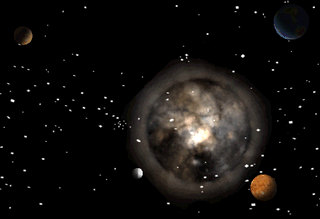Dark Solar System
- Category
- Shell and Desktop
- School Screen Savers

- Developer: Icon Empire
- Home page: iconempire.com
- License type: Free
- Size: 539.19 KB
- Download
Review
In cosmology, dark energy is a hypothetical form of energy which permeates all of space and has strong negative pressure. According to the theory of relativity, the effect of such a negative pressure is qualitatively similar to a force acting in opposition to gravity at large scales. Invoking such an effect is currently the most popular method for explaining recent observations that the universe appears to be expanding at an accelerating rate, as well as accounting for a significant portion of the missing mass in the universe. Two proposed forms for dark energy are the cosmological constant, a constant energy density filling space homogeneously, and quintessence, a dynamic field whose energy density can vary in time and space. Distinguishing between the alternatives requires high-precision measurements of the expansion of the universe to understand how the speed of the expansion changes over time. The rate of expansion is parameterized by the cosmological equation of state. Measuring the equation of state of dark energy is one of the biggest efforts in observational cosmology today. Adding a cosmological constant to the standard theory of cosmology (i.e. the FLRW metric) has led to a model for cosmology known as the Lambda-CDM model. This model agrees closely with established cosmological observations. As NASA reports indicate, 70 percent or more of the universe consists of dark energy, about which we know next to nothing. At the beginning of March, 2006 the satellite of China National Space Administration, DARKSTAR started operations, observing in neutrino the solar corona. It results a sensational information that our system also contains dark energy. This substance is located within the solar surface. We have placed above cosmological information into our screensaver and you can view allocation of dark matter in our Solar system!